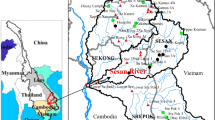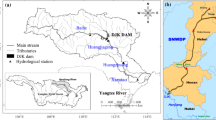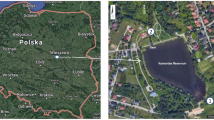Abstract
Diversion hydroelectric facilities are proliferating worldwide, yet how they alter water quality has seldom been assessed. This study evaluates effects of a nearly “run-of-river” diversion hydropower dam (210 MW capacity) on water quality in the Correntes River, a tributary to the Pantanal floodplain of Brazil. Water quality was analyzed from eight locations before and after reservoir construction. Relative to an upstream reference site, the reservoir significantly decreased turbidity (mean, 38%) and concentrations of total solids (23%), total phosphorus (28%), and nitrate (14%). Most changes occurred in the upstream segment of the reservoir (except for turbidity). Only turbidity and nitrate were affected by reservoir operator control of the hydraulic retention time, which ranged from 7.3 to 21.2 days. Overall, the most consequential changes in downstream water quality may be sediment and associated phosphorus retention, which over the long term could affect channel geomorphology and reduce floodplain biological productivity.





Similar content being viewed by others
References
Abe, D. S., T. Matsumura-Tundisi, O. Rocha & J. G. Tundisi, 2003. Denitrification and bacterial community structure in the cascade of six reservoirs on a tropical river in Brazil. Hydrobiologia 504: 67–76.
ABNT (Associação Brasileira de Normas Técnicas), 1992a: Água – determinação de fósforo – método de ensaio: 12.772. Rio de Janeiro, Brazil.
ABNT (Associação Brasileira de Normas Técnicas), 1992b: Águas – determinação de nitrato – métodos do ácido cromotrópico e do ácido fenoldissulfônico: 12.620. Rio de Janeiro, Brazil.
Ahearn, D. S., R. W. Sheibley & R. A. Dahlgren, 2005. Effects of river regulation on water quality in the lower Mokelumne River, California. River Research and Applications 21: 651–670.
APHA (American Public Health Association), 2005. Standard methods for the examination of Water and Wastewater. American Public Health Association, Washington, DC.
Burford, M., S. Green, A. Cook, S. Johnson, J. Kerr & K. O’Brien, 2012. Sources and fate of nutrients in a subtropical reservoir. Aquatic Sciences 74: 179–190.
Carvalho, N. O., L. G. Guilhon & P. A. Trindade, 2000. O assoreamento de um pequeno reservatório – Itiquira, um estudo de caso. Revista Brasileira de Recursos Hídricos 5: 69–79.
CETESB (Companhia de Tecnologia de Saneamento Ambiental), 1998: Guia de coleta e preservação de amostras de água. São Paulo.
Cheng, C., B. Liu, K. W. Chau, G. Li & S. Liao, 2015. China’s small hydropower and its dispatching management. Renewable & Sustainable Energy Reviews 42: 43–55.
David, M. B., L. G. Wall, T. V. Royer & J. L. Tank, 2006. Denitrification and the nitrogen budget of a reservoir in an agricultural landscape. Ecological Applications 16: 2177–2190.
Fantin-Cruz, I., O. Pedrollo, C. C. Bonecker, D. Motta-Marques & S. Loverde-Oliveira, 2010. Zooplankton density prediction in a flood lake (Pantanal–Brazil) using artificial neural networks. International Review of Hydrobiology 95: 330–342.
Fantin-Cruz, I., O. Pedrollo, N. M. R. Castro, P. Girard, P. Zeilhofer & S. K. Hamilton, 2011. Historical reconstruction of floodplain inundation in the Pantanal (Brazil) using neural networks. Journal of Hydrology 399: 376–384.
Fantin-Cruz, I., O. Pedrollo, S. C. Bonecker & P. Zeilhofer, 2015a. Key factors in vertical mixing processes in a reservoir bordering the Pantanal floodplain, Brazil. Hydrological Sciences Journal 60: 1508–1519.
Fantin-Cruz, I., O. Pedrollo, P. Girard, P. Zeilhofer & S. K. Hamilton, 2015b. Identifying and mitigating the effects of a diversion hydropower facility on the hydrological regime of a tributary to the Pantanal floodplain. Journal of Hydrology (in press).
Fonseca, R., T. Canário, M. Morais & F. J. A. S. Barriga, 2011. Phosphorus sequestration in Fe-rich sediments from two Brazilian tropical reservoirs. Applied Geochemistry 26: 1607–1622.
Friedl, G. & A. Wüest, 2002. Disrupting biogeochemical cycles – consequences of damming. Aquatic Sciences 64: 55–65.
Garnier, J., B. Leporcq, N. Sanchez & X. Philippon, 1999. Biogeochemical mass-balances (C, N, P, Si) in three large reservoirs of the Seine Basin (France). Biogeochemistry 47: 119–146.
Gleick, P. H., 1992. Environmental consequences of hydroelectric development: the role of facility size and type. Energy 17: 735–747.
Gonçalves, H. C., M. A. Mercante & E. T. Santos, 2011. Hydrological cycle. Brazilian Journal of Biology 71: 241–253.
Graf, W. L., 2006. Downstream hydrologic and geomorphic effects of large dams on American rivers. Geomorphology 79: 336–360.
Gruca-Rokosz, R., J. A. Tomaszek & P. Koszelnik, 2009. Denitrification in the sediment of a eutrophic reservoir measured with the isotope pairing technique. Oceanological and Hydrobiological Studies 38: 75–81.
Hamilton, S. K., O. Corrêa de Souza & M. E. Coutinho, 1998. Dynamics of floodplain inundation in the alluvial fan of the Taquari River (Pantanal, Brazil). Verhandlungen International Vereiniging Limnology 26: 916–922.
Harris, M. B., W. Tomas, G. Mourão, C. J. Silva, E. Guimarães, F. Sonoda & E. Fachin, 2005. Safeguarding the Pantanal Wetlands: threats and conservation initiatives. Conservation Biology 19: 714–720.
Harrison, J. A., R. J. Maranger, R. B. Alexander, A. E. Giblin, P. A. Jacinthe, E. Mayorga, S. P. Seitzinger, D. J. Sobota & W. M. Wollheim, 2009. The regional and global significance of nitrogen removal in lakes and reservoirs. Biogeochemistry 93: 143–157.
Hennig, T., W. Wang, Y. Feng, X. Ou & D. He, 2013. Review of Yunnan’s hydropower development. Comparing small and large hydropower projects regarding their environmental implications and socio-economic consequences. Renewable & Sustainable Energy Reviews 27: 585–595.
Henry, R., 1999. Heat budgets, thermal structure and dissolved oxygen in Brazilian reservoirs. In Tundisi, J. G. & M. Straškraba (eds), Theoretical Reservoir Ecology and its Applications. Brazilian Academy of Science and Backhuys Publishers, São Carlos, Brazil, International Institute of Ecology: 125–151.
Ismail, W. R. & S. A. M. Najib, 2011. Sediment and nutrient balance of Bukit Merah Reservoir, Perak (Malaysia). Lakes and Reservoirs: Research and Management 16: 179–184.
Junk, W. J. & C. N. Cunha, 2005. Pantanal: a large South American wetland at a crossroads. Ecological Engineering 24: 391–401.
Kennedy, R., 1999. Reservoir design and operation: limnological implications and management opportunities. In Tundisi, J. G. & M. Straškraba (eds), Theoretical Reservoir Ecology and its Applications. Brazilian Academy of Science and Backhuys Publishers, São Carlos, Brazil, International Institute of Ecology: 1–28.
Kennedy, R. H. & W. W. Walker, 1990. Reservoir nutrient dynamics. In Thornton, K. W., B. L. Kimmel & F. E. Payne (eds), Reservoir Limnology: Ecological Perspectives. Wiley-Interscience, New York: 109–132.
Kibler, K. M. & D. D. Tullos, 2013. Cumulative biophysical impact of small and large hydropower development in Nu River. China. Water Resources Research 49(6): 3104–3118.
Kingsford, R. T., 2000. Review: ecological impacts of dams, water diversions and river management of floodplain wetlands in Australia. Austral Ecology 25: 109–127.
Kõiv, T., T. Nõges & A. Laas, 2011. Phosphorus retention as a function of external loading, hydraulic turnover time, area and relative depth in 54 lakes and reservoirs. Hydrobiologia 660: 105–115.
Kondolf, G. M., 1997. Hungry water: effects of dams and gravel mining on river channels. Environmental Management 21: 533–551.
Kumar, D. & S. S. Katoch, 2014. Sustainability indicators for run of the river (RoR) hydropower projects in hydro rich regions of India. Renewable & Sustainable Energy Reviews 35: 101–108.
Kunz, M. J., A. Wüest, B. Wehrli, J. Landert & D. B. Senn, 2011. Impact of a large tropical reservoir on riverine transport of sediment, carbon, and nutrients to downstream wetlands. Water Resources Research 47: W12531.
Lessard, J. L. & D. B. Hayes, 2003. Effects of elevated water temperature on fish and macroinvertebrate communities below small dams. River Research and Applications 19: 721–732.
Loverde-Oliveira, S. M., V. L. M. Huszar, N. Mazzeo & M. Scheffer, 2009. Hydrology-driven regime shifts in a shallow tropical lake. Ecosystems 12: 807–819.
Machado, F. A., 2009. Hábitos alimentares de peixes no Pantanal Matogrossense. In: Bacia do Rio Cuiabá – Uma abordagem socioambiental. Figueiredo, D. M. & F. X. T. Salomão (Org.). Entrelinhas: EdUFMT, Cuiabá, Brasil; 73–83.
Mantel, S. K., D. A. Hughes & N. W. J. Muller, 2010. Ecological impacts of small dams on South African rivers Part 1: drivers of change – water quantity and quality. Water SA 36: 351–360.
Martins, D. E. C., M. E. B. Seiffert & M. Dziedzic, 2013. The importance of clean development mechanism for small hydro power plants. Renew. Energy 60: 643–647.
Naliato, D. A. O., M. G. Nogueira & G. Perbiche-Neves, 2009. Discharge pulses of hydroelectric dams and their effects in the downstream limnological conditions: a case study in a large tropical river (SE Brazil). Lakes and Reservoirs: Research and Management 14: 301–314.
Olden, J. D. & R. J. Naiman, 2010. Incorporating thermal regimes into environmental flows assessments: modifying dam operations to restore freshwater ecosystem integrity. Freshwater Biology 55: 86–107.
Poff, N. L., J. D. Allan, M. B. Bain, J. R. Karr, K. L. Prestegaard, B. D. Richter, R. E. Sparks & J. C. Stromberg, 1997. The natural flow regime: a paradigm for river conservation and restoration. BioScience 47: 769–784.
Principe, R. E., 2010. Ecological effects of small dams on benthic macroinvertebrate communities of mountain streams (Córdoba, Argentina). Annales de Limnologie - International Journal of Limnology 46: 77–91.
R Development Core Team, 2011: R: A language and environment for statistical computing. R Foundation for Statistical Computing, Vienna, Austria.
Reid, N. J. & S. K. Hamilton, 2007. Controls on algal abundance in a eutrophic river with varying degrees of impoundment (Kalamazoo River, Michigan, USA). Lake and Reservoir Management 23: 219–230.
Renöfält, B. M., R. Jansson & C. Nilsson, 2010. Effects of hydropower generation and opportunities for environmental flow management in Swedish riverine ecosystems. Freshwater Biology 55: 49–67.
Roberto, M. C., N. F. Santana & S. M. Thomaz, 2009. Limnology in the Upper Paraná River floodplain: large-scale spatial and temporal patterns, and the influence of reservoirs. Brazilian Journal of Biology 69: 717–725.
Rodriguez, M. A. & W. M. Lewis Jr, 1997. Structure of fish assemblages along environmental gradients in floodplain lakes of the Orinoco River. Ecological Monographs 67: 109–128.
Seitzinger, S. P., R. V. Styles, E. W. Boyer, R. B. Alexander, G. Billen, R. W. Howarth, B. Mayer & N. Breemen, 2002. Nitrogen retention in rivers: model development and application to watershed in the northeastern USA. Biogeochemistry 57(58): 199–237.
Seitzinger, S. P., J. A. Harrison, E. Dumont, A. H. W. Beusen & A. F. Bouwman, 2005. Sources and delivery of carbon, nitrogen, and phosphorus to the coastal zone: an overview of Global Nutrient Export from Watersheds (NEWS) models and their application. Global Biogeochemical Cycles 19: GB4S01.
Seitzinger, S. P., E. Mayorga, A. F. Bouwman, C. Kroeze, A. H. W. Beusen, G. Billen, G. Van Drecht, E. Dumont, B. M. Fekete, J. Garnier & J. A. Harrison, 2010. Global river nutrient export: a scenario analysis of past and future trends. Global Biogeochemical Cycles 24: GB0A08.
Soares, M. C. S., M. M. Marinho, V. L. M. Huszar, C. W. C. Branco & S. M. F. O. Azevedo, 2008. The effects of water retention time and watershed features on the limnology of two tropical reservoirs in Brazil. Lakes and Reservoirs: Research and Management 13: 257–269.
Soares, M. C. S., M. M. Marinho, S. M. O. F. Azevedo, C. W. C. Branco & V. L. M. Huszar, 2012. Eutrophication and retention time affecting spatial heterogeneity in a tropical reservoir. Limnologica 42: 197–203.
Souza Filho, E. E., 2013. As barragens na bacia do rio Paraguai e a possível influência sobre a descarga fluvial e o transporte de sedimentos. Boletim de Geografia 31: 117–133.
Stanford, J. A. & J. V. Ward, 2001. Revisiting the serial discontinuity concept. Regulated Rivers: Research and Management 17: 303–310.
Stanley, E. H. & M. W. Doyle, 2002. A geomorphic perspective on nutrient retention following dam removal. BioScience 52: 693–701.
Straškraba, M., 1999. Retention time as a key variable of reservoir limnology. In Tundisi, J. G. & M. Straškraba (eds), Theoretical Reservoir Ecology and its Applications. International Institute of Ecology, Brazilian Academy of Science and Backhuys, Rio de Janeiro.
Straškraba, M. & J. G. Tundisi, 1999. Reservoir ecosystem functioning: theory and application. In Tundisi, J. G. & M. Straškraba (eds), Theoretical Reservoir Ecology and its Applications. International Institute of Ecology, Brazilian Academy of Science and Backhuys Publishers, São Carlos: 565–597.
Straškraba, M., I. Dostálková, J. Hejzlar & V. Vyhnálek, 1995. The effect of reservoirs on phosphorus concentration. Internationale Revue der gesamten Hydrobiologie und Hydrographie 80: 403–413.
Thornton, K. W., 1990. Sedimentary processes. In Thornton, K. W., B. L. Kimmel & F. E. Payne (eds), Reservoir Limnology: Ecological Perspectives. Wiley-Interscience, New York: 43–69.
Viana, J. P., 2002. Physical and chemical post-dam alterations in the Jamari River, a hydroelectric-developed river of the Brazilian Amazon. Hydrobiologia 472: 235–247.
Vörösmarty, C. J., M. Meybeck, B. Fekete, K. Sharma, P. Green & J. P. M. Syvitski, 2003. Anthropogenic sediment retention: major global impact from registered river impoundments. Global and Planetary Change 39: 169–190.
Wang, B., I. Nistor, T. Murty & Y.-M. Wei, 2014. Efficiency assessment of hydroelectric power plants in Canada: a multi criteria decision making approach. Energy Economics 46: 112–121.
Ward, J. V. & J. A. Stanford, 1983. The serial discontinuity concept of lotic ecosytems. In Fontaine, T. D. & S. M. Bartell (eds), Dynamics of Lotic Ecosystems. Ann Arbor Science Publishers, Michigan: 29–42.
Ward, J. V. & J. A. Stanford, 1995. The serial discontinuity concept: extending the model to floodplain rivers. Regulated Rivers: Research and Management 10: 159–168.
Wetzel, R. G., 2001. Limnology. Lake and River Ecosystems, 3rd ed. Elsevier Academic Press, College Park.
Zeilhofer, P. & R. M. P. Moura, 2009. Hydrological changes in the northern Pantanal caused by the Manso dam: impact analysis and suggestions for mitigation. Ecological Engineering 35: 105–117.
Ziv, G., E. Baran, S. Nam, I. Rodriguez-Iturbe & S. Levin, 2012. Trading-off fish biodiversity, food security, and hydropower in the Mekong River Basin. Proceedings of the National Academy of Sciences USA 109: 5609–5614.
Acknowledgments
The authors express sincere thanks to Tractebel Energia SA for providing access to historic data in the environmental monitoring plan of the UH Ponte de Pedra reservoir; to the environmental analyst Veríssimo Alves dos Santos Neto for support using the data archive, and for explaining how the reservoir functions; and to the biologist Claudiano Souza for support during field visits. The authors are indebted to FAPEMAT (46552/2013) and The Nature Conservancy (AFCS 304/2011) for financial support, and to the Brazilian National Council for Scientific and Technological Development (CNPq) for fellowships to I.F.C.
Author information
Authors and Affiliations
Corresponding author
Additional information
Handling editor: John M. Melack
Rights and permissions
About this article
Cite this article
Fantin-Cruz, I., Pedrollo, O., Girard, P. et al. Changes in river water quality caused by a diversion hydropower dam bordering the Pantanal floodplain. Hydrobiologia 768, 223–238 (2016). https://doi.org/10.1007/s10750-015-2550-4
Received:
Revised:
Accepted:
Published:
Issue Date:
DOI: https://doi.org/10.1007/s10750-015-2550-4




